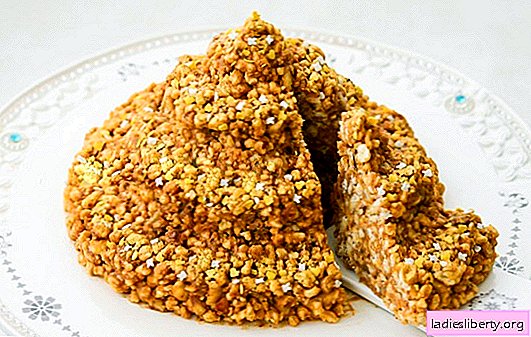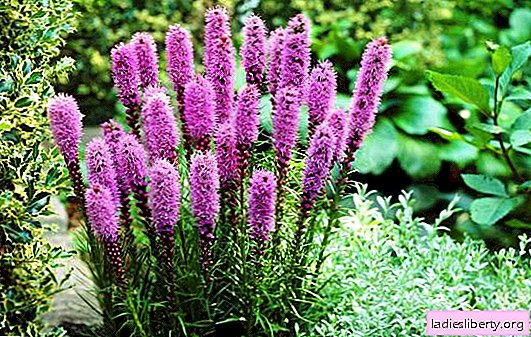
Liatris is a beautiful flowering perennial native to North America. Its arrow-shaped inflorescences are covered with many small buds that bloom alternately from top to bottom. The duration of flowering is from July to August, some varieties bloom in the colder season.
Liatris - an excellent honey plant, has a pleasant smell. Bees and other insects useful for the garden always accumulate around this plant. Growing a lyatris does not cause trouble, the plant belongs to unpretentious garden perennials.
Features Liatris
The color of the flower arrow of the plant depends on the variety. There are lyatris with purple, white and pink flowers. Many gardeners grow lyatris for cutting. This perennial flowers retain its vanilla flavor for a long time and stand well in a vase.
The plant is very popular in perfumery, it is used to produce essential oils, extracts and as a raw material in the manufacture of perfumes.
Liatris fits into any corner of the garden. It is grown in groups and in combination with any plants you like. Perennial flower arrows look good in the middle of a green lawn.
Growing a lyatris: where to plant a perennial
Although lyatris is considered an unpretentious plant, some breeding conditions must be observed for successful breeding.
1. The right place to land.
Liatris prefers well-lit areas, but easily tolerates partial shade. Planting a perennial in a dense shade makes no sense, since flowering will be sparse and the plant itself weak.
The landing site of the lithatrix should be dry, without close occurrence of groundwater. Swampy areas, lowlands and waterlogged soil are not suitable for plant breeding. In such circumstances, even the best care will not yield results.
2. The composition of the soil.
When growing lyatris, light, well-drained soils should be preferred. In clay heavy soils, the flower will not grow. Perennial is very demanding on the soil, if its soil composition does not fit, then you can not expect flowering. Typically, the flowering period of the lyatris occurs in the driest months.
Outdoor Liatris Care
Liatris is undemanding to care. The whole process consists in weeding, removing faded arrows, moderate watering and mulching. During active growth, the plant is useful to feed.
Soil mulching
Weeding weeds is necessarily accompanied by mulching, as loosening the soil under the bushes is not recommended. This is due to the peculiarity of the root system of the plant, which is located close to the surface of the soil. Mulching is carried out after irrigation or rains, as the earth is washed out from under the bushes, which leads to exposure of the rhizomes. It is necessary to inspect plants in a timely manner and add a new layer of mulching material.
In our latitudes, without additional shelter, the lyatris does not tolerate winters. In preparation for the cold, the plant is spudded and mulched. A thick layer of mulch allows the root system to safely winter.
Watering
Perennial refers to drought tolerant species. Liatris has enough rainwater. But if the summer turned out to be especially hot, it is useful to carry out moderate watering of the plant. The soil under the bushes should not be too wet. Unacceptable and stagnation of water. This leads to rotting of tubers and diseases.
Supplementary food
It is useful to feed the lyatris; for this, mineral fertilizers are used. In spring, nitrogen-containing fertilizers are introduced, and in the summer, they switch to phosphorus-potash. For brighter flowering, the soil around the plants is mulched with a thick layer of compost.
Important! If in the fall the leaves of the lyatris turn pale, then this indicates a lack of nitrogen fertilizers. Mineral granules are additionally added to the soil.
How to propagate lyatris (photo)
Caring for the lyatris, every gardener is faced with the need to propagate a flower. Many do not know how to do it right. Liatris reproduces in several ways:
• seeds;
• division of tubers.
Seed propagation
Perennial is well propagated by seeds. The resulting plants bloom in the second or third year after germination. Planted seeds immediately in open ground.
Planting seeds of lyatris is carried out in spring or late autumn. They dig well the soil before sowing, add mineral fertilizers. The seeds of the plant are soaked in a weak solution of potassium permanganate.
Furrows for sowing do shallow. Seeds fall asleep and mulch. It remains to wait for seedlings, and they appear only in the third year after sowing. This is the only disadvantage of seed propagation of lyatris.
Tuber division
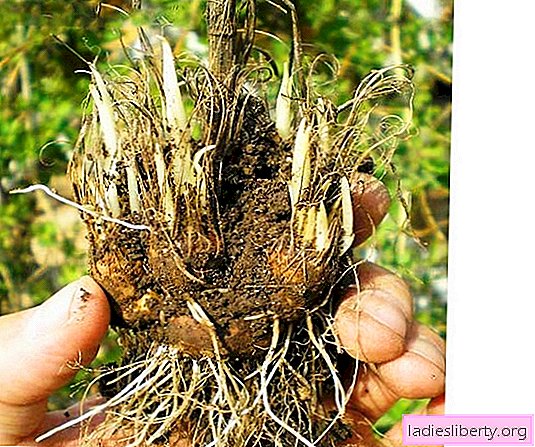
This method is faster and more effective than seed propagation. Experienced flower growers resort to the division of rhizomes in the spring. An important condition in this case is the presence of roots in each delenka. The mother plant is divided so that each seedling has a good root neck and tuber.
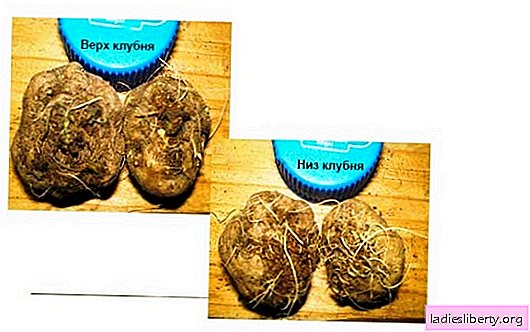
Wells for planting rhizomes are shallow, approximately 20 cm. Compost and mineral fertilizers are added to each hole. The seedlings are sprinkled with earth and mulch well.
The distance between the plantings of the lyatris can withstand up to 25 cm.Perennial propagation is resorted to this species once every four years.
Pests and diseases of lyatris
Liatris is often affected by underground pests. Its tubers are attractive to rodents, bears. In wet weather, the aerial part of the plant is damaged by slugs and snails.
Chemical pesticides are used to control pests, laying them out under perennial bushes. Snails and slugs are caught with special baits. You can resort to folk remedies and sprinkle flower beds with hot pepper, mustard powder. The abdomen of slugs is rather tender and they are not happy with such a "treat".
Types of Liatris (photo)
Today, there are more than 20 species of perennials that are grown in gardens and city parks. Varieties differ in the flowering period and the density of inflorescences. But these differences are not too pronounced, and it is very difficult to distinguish a variety of lyatris.
1. Spikelet Liatris
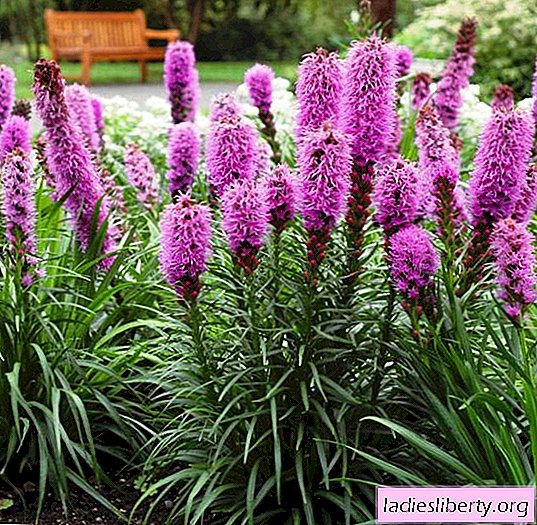
Plant height up to 50 cm, elongated leaves, green. The length of the inflorescence is about 30 cm. The flowering period is short and lasts no more than 45 days. Flowering ends in July.
2. Liatris grungy
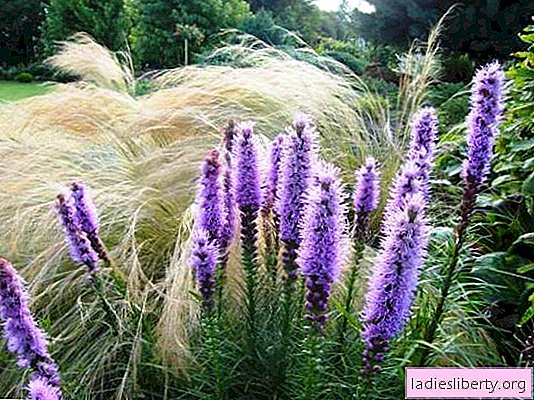
Flower brushes of this variety are painted in lavender. Perennial is a rare species, but tubers can be purchased in specialized stores. There is a white variety of this variety.
3. Filmy Liatris
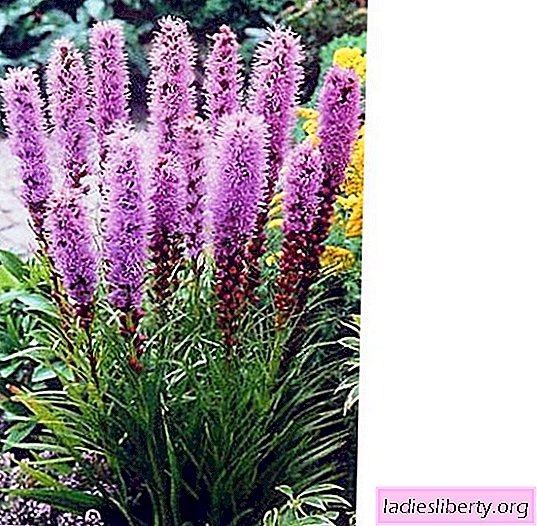
It has high peduncles that reach 1 meter. The color of the flowers is pinkish-lilac, the buds are very large.
The original lyatris is a worthy decoration of the garden. It looks good in planting with irises, phlox, decorative and deciduous perennials. Observing all the above rules for the care and cultivation of the lyatris, you can observe its beauty for more than one year.









